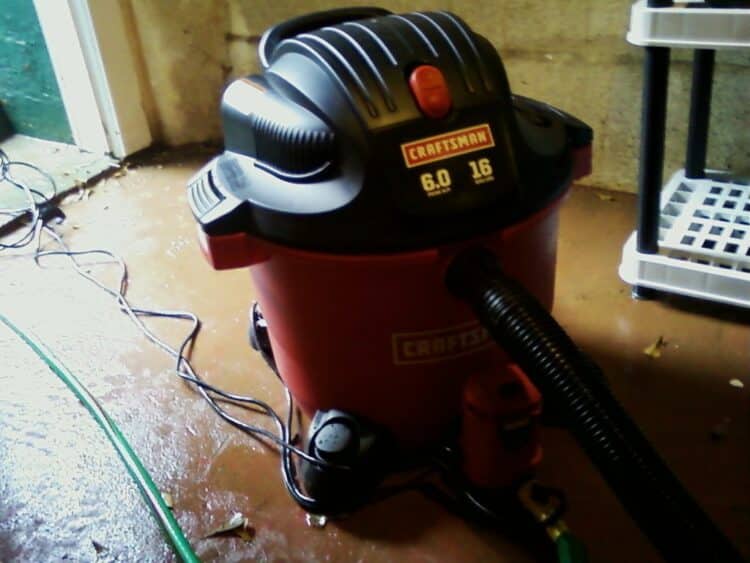
Is my basement leaking in winter? How much does it cost to damp proof a house? Does it have condensation or a leak? Do I know of any wet basement solutions? As a homeowner, these questions will likely arise once your home comes across harsh weather conditions like a rapid outpouring of rain.
A moist basement is a giant pain in the neck. If your basement is not utilized for storage and is a livable area, then any liquid accumulation can damage the drywall, the foundation, and any furniture or carpeting stationed there.
Any form of liquid that might seep in like condensation can collapse any wooden flooring and breed damaging mold.
Table of Contents
What are the causes of damp in old houses?
If you notice any water leak or condensation happening in your old house, you need to find out where it is derived. It usually comes from these sources:
- The water originated from indoors. Condensation happens due to humidity inside the house, similar to droplets of water form on an ice-cold can of Coke on a wet day.
- Water comes from the outside in the form of water vapor. Either melted snow, rainwater, or underground water can infuse in the soil on the foundation of your house and slowly seep in. The damaging liquid can pass through cracks in the wall, or can infiltrate the brick or concrete through its pores.
Further explaining the causes of damp basements
When you see signs of water damage in the basement, then you have to know where exactly it came from. This knowledge will indeed help you one day when water will suddenly appear in your home.
Everything you need to know about condensation
Condensation is a nuisance and especially damaging to homes everywhere. It is also known as “sweating,” since it does look like fluid secretion from a human body.
It will appear suddenly in your home as droplets of water, tiny water puddles, and moist spots on your flooring and walls.
It will occur when warm air comes into contact with cold walls or cool water pipes. In turn, it will moisten carpets, rust furniture, and appliances and make the inside conditions humid and dank.
It will likely happen in cabinets, cupboards, and crawl spaces. Wood rotting will happen, which will encourage a breeding ground for insects. It will also break or collapse any wooden surface.
How to find out if condensation is present
There is an easy way to check if there are condensation problems inside your home, and thus foundation water damage is happening. Look for any accumulation of wetness, then cut a small piece of aluminum foil and tape it over the moist concentration. Go back to it after one day.
When you check on it after a day, if you notice water droplets have formed on the outside surface of the foil, then there is condensation in the air. If you see that droplets have been collected on the interior side, water has leaked in from the outside.
How to keep condensation from happening
There are more easy methods. If your basement is full of assorted stuff, introduce air in the damp environment. Bringing in electric fans to dry out water damage can work. If there are windows, open all of them.
A dehumidifier (if you can afford it) will also work. It can get rid of fifty pints of liquid in one day. Install it near an area where there is drainage.
However, some experts do not recommend this. They assert that if humidity is lessened in a room, additional moisture will eventually come back. It is because liquid looks for areas with low humidity and naturally moves there.
Other experts argue that, even though a hi-dry dehumidifier can attract ten to twenty percent more humidity, it can process and eliminate it.
When winter arrives, switch on the heater to warm up the basement. Enclose your cold water pipes with an insulating material like foam to prevent wet air from interacting with them.
Do not try to use the basement to hang and dry wet clothes and remove anything that may draw in moisture, like firewood.
Damp proofing underground walls will also work. You can do this with a waterproof coating, which has a way to penetrate brick or cement and obstruct its pores. Choose a high-quality one like “UGL’s DryLok Waterproofer” or “Xypex’s Hi-Dry.”
If you do not have a basement, rather a crawl space, you have to do another process. Get a plastic polyethylene sheet that can provide cover for the whole floor space. Make it is enough to overlap the entire floor sides.
Also, it is greatly beneficial if you install air vents in the basement so that air can circulate and dry up any possible wetness.
Once you do all the preventive measures and there is still moisture present, your problem is not condensation.
Runoff
The most common reason your basement or crawl space has unexplained wetness is either rainwater or snow is not directed away from your home and finds a way inside.
Runoff gradually penetrates the soil near the base of your house then slowly seeps in due to hydrostatic pressure. The gaps and cracks in your basement walls are infiltrated by capillary action.
How to check if you have a runoff in your basement
If you have a leaking gutter causing damp in your home, or if your basement or crawl space is suddenly wet after a storm, these are definite indications of runoff.
You have to find any openings or small pathways in the walls for liquids to come in from the outside.
Go outside and examine the groundwork surrounding your home and look for soil inclines that might lead liquid towards your home.
Check if your downspout is not clogged and accumulating water seeping towards the soil near the sides of your home. Check if there are any leaks and put in a downspout seams-out to make examining easier.
Another thing to examine is your street curbs are directing water towards the roadway, going to side canals. Look for any openings and cracks on the cement surface, which can accumulate liquid.
If you are living in a hilly area, then your neighborhood might have a swale. It is a low area where the runoff of the entire neighborhood can be channeled and accumulated. It will look like a marshy area where a lot of plants grow.
This can only serve as a temporary place for runoff because it will become clay, which can lead to your home and can cause damage to your drainage.
Ways in preventing runoff
If your utmost concern is water foundation damage in your basement, then your job is not going to be difficult.
You need to patch up leaks and tiny slits in the foundation and walls. The best material to use is an adhesive synthetic caulk called “Sikaflex” or “UGL’s Masonry Crack Filler.”
The best material to use for large and glaring fissures utilize hydraulic cement. It can produce a good result because it will spread out as it dries. The best products are “Thoro Waterplug,” “Custom Building Product’s Custom Plug,” and “UGL’s Fast Plug.”
To halt the outside entry of runoff happening in your driveway, you can cover cracks and fractures with an asphalt patching compound. If the driveway is concrete, you can cover it with cement.
You also have to be mindful of cleaning the concrete gutters causing damp in your home. When rainy and snowy seasons come, your gutters will be clogged. If your home does not have it, then build one.
Be sure that the groundwork surrounding the foundation is inclined away from the house, approximately one inch per one foot from four feet away. Put extensions in your downspout so that the gutters will gradually fall away from your house onto the canals on the street.
Many homes have a pre-built basement water control system for liquid drainage. However, as time passes, it will become damaged or is filled up with clay and dirt.
One solution for this brings in a professional that can clean it up with a power snake. But most likely, you will be advised by the same repairman to finish it off at the surface and let it be.
Another way is to drain the collected water into a makeshift dry well. It is a hole with gravel inside that will enable water to soak into the soil eventually.
There a dry well you could buy made with a polypropylene material in the form of a tank. Its purpose is to halt the flow of silt and to assist in the drainage process.
It can deal with a large amount of runoff coming from a large roof. Set it up in a hole in the ground, maybe three feet deep and far away from the house. Cover it up soil and put a marking on top, so you will know where it is when it gets full of water.
Planting grass in your front and back yard is a great way to absorb water. It has a dual purpose of beautification and getting rid of excess liquid.
Do not plant trees because once the roots will grow bigger, it will destroy the baseboard drainage system and the foundation of your house.
After doing all the preventions and liquid still enters your home, it’s time to bring in a professional. Also, instead of having gutters on the outside of your house, build one inside your basement. It will go around the basement sides and collects into one place, which you can gather with a sump pump.
Subsurface seepage
If your basement gets in moisture, and no matter what you do to prevent or get rid of it, it still appears, then you are not dealing with runoff. It is another kind of problem, which you need to look for a seepage solution.
You have to find out if you have high groundwater. If the foundation of your house comes from clay, it can repel water and snow. Runoff issues only arrive when harsh weather comes and disappears once the weather clears up.
However, if there is still basement seepage after snow melts or after the storm has passed, and water suddenly appears in the middle of the floor or seeping through the walls, you may have a problem with groundwater.
If this happens, then you have to consult with your local government’s water systems management. They can tell you if your area has a high water table or there is water flowing underground.
This issue cannot be fixed by yourself. You need to call a professional contractor to handle these. The solution they may offer would either be incorporating the soil in the foundation of your home with absorbent clay or covering urethane caulk in the wall cracks or making a well and buying a sump pump.
The contractor may also advise you to install PVC drainage pipes surrounding the interior of your home and covered with gravel. Whenever water seeps in, it is channeled towards the pipes, which then leads it outside. This type of work is expensive and will cost from $3k to $5k.
A more expensive way is setting up a wet drainage system on the outside. It requires more work and is complicated.
The whole process involves displacing your garden landscape, digging the soil to make the foundation accessible, blanketing it with a waterproof material, and laying down the drainage system in the gravel. It will cost about 10k.
Doing everything right is essential in halting groundwater to seep into your basement. So you have to make sure that your contractor knows what he is doing and can provide you these items:
- He can provide you insurance and can guarantee that he can deliver in his task.
- He can give you specific and detailed costing on home much you will spend.
- Ask around about the contractor if they have a good reputation and provides good service.
Leaky basement solutions and is causes
Examine the type of soil in the foundation
Cause: When your home was built, the groundwork surrounding the foundation was excavated and refilled with loose dirt, which will stabilize more than the unused soil.
As time passes after your home has been constructed, the soil compacts and creates an incline going down towards the house. The lowest areas close to the house will direct any outpouring of water towards it and accumulate at the edges of the foundation, which will try to pass through the wall cracks.
Solution: Basement solutions start by examining the dirt surrounding your house. If the groundwork does not incline to a downward drop, then you have to re-grade the soil surrounding the house to solve the problem. You have to bring in outside soil and place it around the house change the incline of the slope.
Observe the cement walkways and patios
Cause: If your brick or cement pavers and walkways are not correctly inclined, it can direct any liquid towards the foundation. If your building contractor knew what he was doing, he had created an incline away from the house by ¼ inch angle per horizontal foot.
The way contractors build patios is that they try to mimic the shape of a cone so that any liquid outpouring is directed towards the center. The water leads to a drainage pipe and is dispersed out to the lawn.
Solution: This is a problem that is hard to fix. Your brick walkway or paver needs a total overhaul. The bricks and concrete need to be disassembled from the base and constructed to the right incline.
A small dam can be created along the boundary of the walkway before joining the house. You also need to seal the brick or cement with a great sealant material. After doing this, water is channeled away from the foundation.
Be sure that your roof has working gutters with appropriate downspouts that lead water away from your house.
Check if your driveway has an incline
Cause: An incorrectly inclined driveway can lead liquid towards the house and into the basement. It can store a lot of water, so proper drainage is beneficial.
It is common in neighborhoods where one driveway is shared and water reaches the foundation of each house. Strong rain pours excess water onto their roofs and lands on the driveway.
Solution: The seepage solution is constructing a gutter in between both foundations. This way, the water would be directed towards the street instead of towards the house.
Examine the downspout from your roof
Cause: If you live in an area where many torrential storms occur, you need to install a downspout that collects water from your roof. It is designed to dump water at the foundation base. Sometimes, rainfall is too much, and it might seep inside your home.
Solution: To fix this, you need to install your downspouts with long horizontal extenders. Be sure it will lead away from your house, onto a place where water is absorbed, like your front yard or garden.


